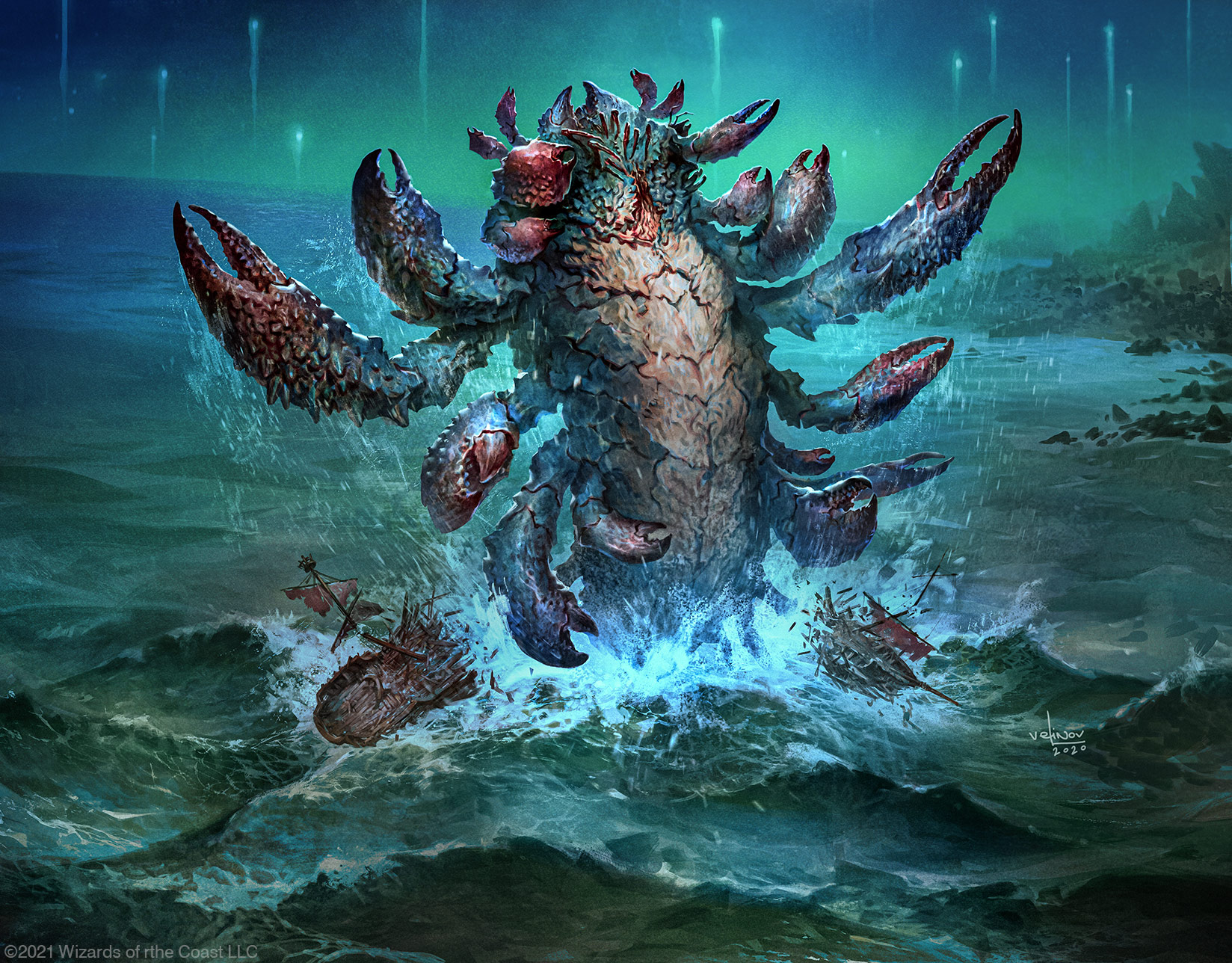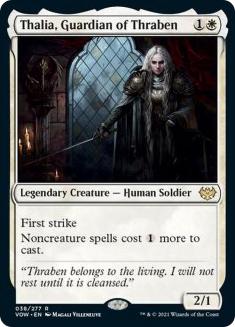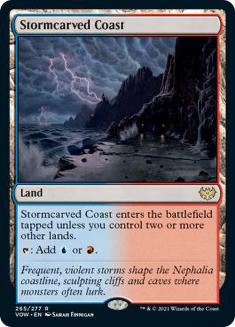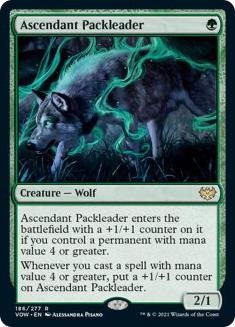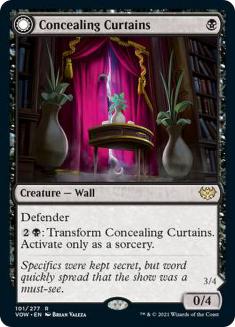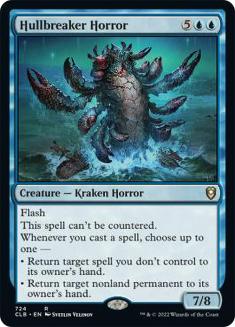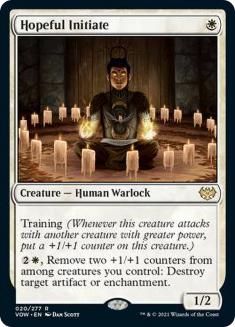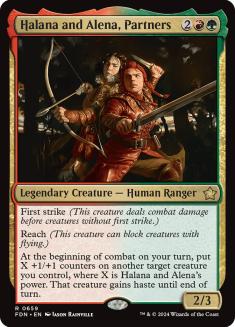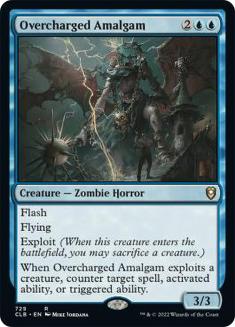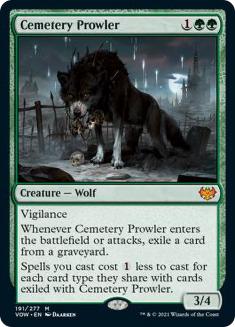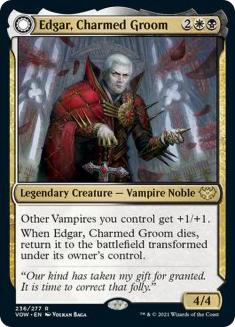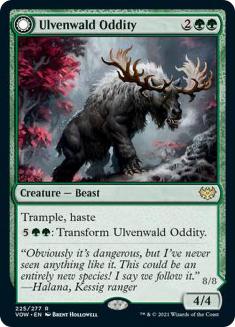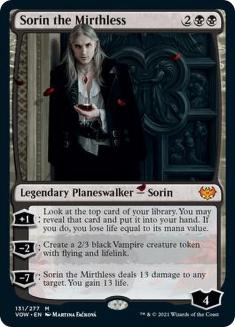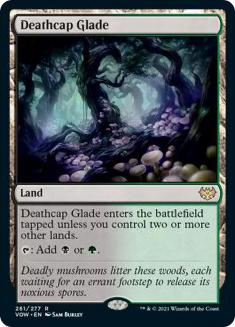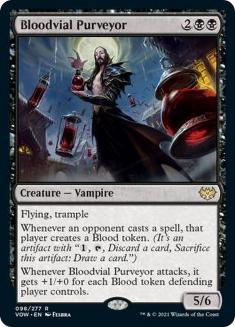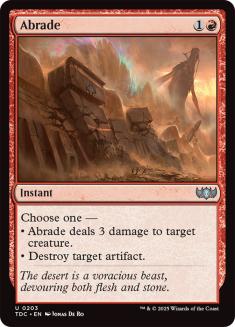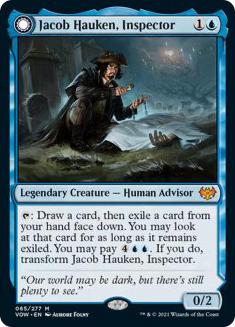Welcome to Innistrad: Crimson Vow Exit Interview week!
If you missed Innistrad: Crimson Vow First Impressions week, various members of the SCG Staff shared their thoughts on their Top 5 Innistrad: Crimson Vow cards in each format before having the opportunity to play with them. With Kamigawa: Neon Dynasty preview season almost upon us, we thought it would be fun to have those same folks update their lists now that they’ve had the opportunity to play with Innistrad: Crimson Vow for the past six weeks and share what they got right, what they got wrong, what surprised them, etc.
Just like last time, today we’ll begin with Standard, Wednesday will be Historic, and Thursday will be Modern. The same scoring system we had in place for Innistrad: Crimson Vow First Impressions week will be in place here so that we can get an idea of what card ranked in what place in the aggregate to close out each article. The scoring system is as follows:
- 1st — 5 points
- 2nd — 4 points
- 3rd — 3 points
- 4th — 2 points
- 5th — 1 point
Let’s start this party off with, once again, PVDDR!
Paulo Vitor Damo da Rosa
Previous List
- Thalia, Guardian of Thraben
- Stormcarved Coast
- Ascendant Packleader
- Concealing Curtains
- Hullbreaker Horror
New List
- Stormcarved Coast
- Hullbreaker Horror
- Hopeful Initiate
- Halana and Alena, Partners
- Ascendant Packleader
With the release of Innistrad: Crimson Vow, I expected the Izzet decks to be the best decks, but I expected there to be some debate about it, since they hadn’t gained that much from the new set. The reality, however, is that Innistrad: Crimson Vow did not meaningfully change Standard and the Izzet decks are still way too good, and as such I’m picking Stormcarved Coast as the most important card in the set, even though it’s not really a key piece for the deck. I believe that, if this land didn’t exist, the deck would not operate much differently (though it would obviously be weaker).
Hullbreaker Horror comes in second place, because even though I don’t actually like it that much in the maindeck of the Izzet decks, I think it has the ability to warp both deckbuilding and deck selection. Sometimes it’s a blank Game 1, but in other spots it also just wins you the game, and it has the potential to be the most important sideboard card in the blue mirrors.
The next three slots are honestly interchangeable, and there are a couple of cards that could have made it instead (such as Thalia, Guardian of Thraben; Valorous Stance; Ulvenwald Oddity; Wedding Announcement; or Edgar, Charmed Groom). These cards are arguably more important to their respective decks than either of the previous cards are to Izzet, but these decks are just worse, which means the cards become less powerful as well.
My choice for third place and most important card for Mono-White Aggro❄ might be a bit surprising — most people would expect Thalia, Guardian of Thraben instead. Thalia is a strong card, but it didn’t have the impact I expected it would have in the metagame because the format is sort of hostile to one-toughness creatures; every Izzet deck has Spikefield Hazard, the black decks have Shambling Ghast and The Meathook Massacre, and the green decks go over the top of a 2/1. As a result, my choice is Hopeful Initiate, which I believe is stronger than Thalia in the deck — it’s actually a pretty powerful one-drop and that’s the advantage white decks have over the other aggro builds.
My fourth place is Halana and Alena, Partners, which surprised me a bit. When I saw the set list, I thought it had a powerful effect, but that the competition was a little bit too strong in the four-drop slot. I did, however, identify it as a card that could see play in a Gruul deck, so the fact that it is seeing play isn’t too surprising. What caught me completely off-guard, however, was double splashing for it in white decks. That I would never have seen coming, but it’s happened enough that I have to accept it as legitimate.
#5 is basically a toss-up between Ascendant Packmaster and Ulvenwald Oddity. I expected Ascendant Packmaster to be a game-changer, but it turns out it’s just okay, as is the Oddity. Together I think they represent “Mono-Green Aggro” in this list, and, while the deck deserves to be represented, it’s nothing to write home about.
Overall, the impact of Innistrad: Crimson Vow was regrettably very low, and the decks that were good before are basically the decks that are good now, with a few changes. If I had a Standard tournament to play right now, I would basically always play Izzet, as I think it’s by far the best deck and there’s nothing you can’t beat between deck and sideboard.
Bryan Gottlieb
Previous List
- Stormcarved Coast
- Ascendant Packleader
- Overcharged Amalgam
- Hullbreaker Horror
- Cemetery Prowler
New List
- Stormcarved Coast
- Hullbreaker Horror
- Thalia, Guardian of Thraben
- Ascendant Packleader
- Edgar, Charmed Groom
I really wanted to be wrong about Innistrad: Crimson Vow. Sure, I got a couple of my individual picks wrong. Overcharged Amalgam and Cemetery Prowler have not really materialized into metagame-defining forces, though each has seen meaningful spot play. What I really nailed was my assessment of Innistrad Crimson Vow’s overall impact.
As far as Hullbreaker Horror goes, I’m happy I spotted its potential early, but there’s no question I was conservative in my assessment of its capabilities. The only reason you’re not even more sick of Hullbreaker Horror is because Alrund’s Epiphany exists. Card is a messed-up end-game that would be the closer for a huge percentage of Standard decks if there wasn’t a way to go even larger.
Leaving Thalia, Guardian of Thraben off my initial list was more of a statement than anything. People were approaching the card as an absolute game-changer, destined to banish Izzet to the shadow realm. I thought it was pretty good. I still think it’s pretty good. It’s just that I think most of the other stuff in the set is a lot worse now, and at least Thalia slots into the current paradigm of play. I could have gone with Hopeful Initiate, but I consider the inclusion of Thalia on my revised list as a mea culpa.
I chose to round my list out with Edgar, Charmed Groom, not because I think the card is great, but because it inspired the most efforts to break out of Standard’s rigid framework. Things like Orzhov Control and even Mardu Vampires had brief moments in the sun. Neither deck had staying power, but Edgar brought a new midrange end-game to the table that wasn’t present previously. Sure, it didn’t beat anyone, but it tried its best.
Standard feels like it’s rotting on the vine right now. I am hopeful that Kamigawa: Neon Dynasty is the shake-up the format deserves and I get to come back here and write an unabashedly excited Top 5 list.
Dom Harvey
Previous List
- Thalia, Guardian of Thraben
- Stormcarved Coast
- Ascendant Packleader
- Concealing Curtains
- Hullbreaker Horror
New List
- Stormcarved Coast
- Ascendant Packleader
- Ulvenwald Oddity
- Hullbreaker Horror
- Thalia, Guardian of Thraben
If Stormcarved Coast was the top card in Innistrad: Crimson Vow, the set can only be a failure for Standard. Izzet Epiphany was the best deck by far before. It’s still the best deck by far now. If anyone were still paying attention to Standard, we would be desperately praying for a game-changer in Kamigawa: Neon Dynasty. Stormcarved Coast is the least important card on this list in terms of its effect on the format — if your mana was fine before, spells will change more than lands will by default — but it feels only correct to put it here as a strict upgrade for the best deck.
Ascendant Packleader and Ulvenwald Oddity are next on the list as a package deal. Ascendant Packleader was an obvious hit for an aggro deck that wants to curve out but lacked a one-drop for that previously — and one-drops in general are valuable against Fading Hope, which was preferred over permanent removal against Mono-Green Aggro❄ before. Ulvenwald Oddity is the one card here that didn’t make my original list, but it has overperformed as another curve-topper alongside Esika’s Chariot over other options like Wrenn and Seven or Unnatural Growth.
Games with and against Mono-Green Aggro❄ often revolve around the possibility of Oddity, and transforming it is a game-winning mana sink for a deck with a high land count (bolstered by Kazandu Mammoth) and Sculptor of Winter. In Alchemy, where Esika’s Chariot has been nerfed, the digital-only Lupine Harbingers acts as welcome redundancy for Oddity as your premiere threat.
For a brief moment I was regretting not giving Hullbreaker Horror top billing here, but the initial hype quickly evaporated. It’s still a phenomenally powerful card that we’d be sick of by now if it were more popular and I expect it to be a menace in Alchemy, where Alrund’s Epiphany is powered down and Key to the Archive curves into Horror perfectly.
Thalia, Guardian of Thraben wasn’t the saviour Standard needed; instead of vaulting Mono-White Aggro❄ to the top tier, Thalia lets it cling to some hope of playability.
Shaheen Soorani
Previous List
- Thalia, Guardian of Thraben
- Ulvenwald Oddity
- Ascendant Packleader
- Sorin the Mirthless
- Deathcap Glade
New List
- Hullbreaker Horror
- Thalia, Guardian of Thraben
- Ascendant Packleader
- Halana and Alena, Partners
- Ulvenwald Oddity
My initial Top 5 list was not far off from the new and improved version you see here. Hullbreaker Horror and Thalia, Guardian of Thraben still run the show, being the two most impactful cards in Standard from Innistrad: Crimson Vow. Hullbreaker Horror was a bit unnecessary, as the decks it has enhanced would have been fine without it. Since Izzet Epiphany and Dimir Control (or Esper Control) have such a powerful foundation, Hullbreaker Horror is not a make-or-break addition to these archetypes. We still see them flourish in competitive play, only challenged by the beatdown decks that the rest of this list gives a nod to.
Thalia made Mono-White Aggro❄ viable once again, giving the deck teeth against these blue-based heavy hitters. There are other additions from Innistrad: Crimson Vow; however, they do not register the same impact that the returning control killer does. Like Thalia, Ascendant Packleader and Ulvenwald Oddity arrived right on time, making Mono-Green Aggro❄ powerful enough to regain the territory it was rapidly losing.
After the SCG Invitational in October, it was quite apparent that Mono-Green Aggro❄ didn’t have the strength to beat strong players piloting blue decks in Standard. The entire Top 8 had nearly identical decks, after feasting on Mono-Green Aggro❄ the entire tournament. The addition of Ascendant Packleader gave it a viable one-drop plan, which was woefully lacking prior to its arrival. To add some more mid-game muscle, Ulvenwald Oddity joined the team as well, making Mono-Green a force to be reckoned with. To my utmost dismay, Mono-Green is likely one of the best decks in Standard once again, due to it not automatically folding to the blue decks.
The last addition to my new Top 5 is Halana and Alena, Partners. It wasn’t on my radar at all, but it is now apparent how impactful this card has been. It has lifted Naya and Gruul Midrange to relevancy, being seen in each stock decklist in recent results. My initial predictions were right on the money, except for this Gruul gem. Standard is still not in a great place, even with the additions of Innistrad: Crimson Vow. I know many are ready to abandon ship and not look back, but I hope it doesn’t come to that. If the design team can circle back, return to their original philosophy, and make the necessary adjustments, then the format may have a fighting chance.
Ari Lax
Previous List
- Concealing Curtains
- Bloodvial Purveyor
- Abrade
- Jacob Hauken, Inspector
- Mulch
New List
- Ascendant Packleader
- Thalia, Guardian of Thraben
- Hullbreaker Horror
- Edgar, Charmed Groom
- Halana and Alena, Partners
That is a full zero for five on my initial guesses, though Concealing Curtain is in the next few spots. What went wrong?
I’m pretty sure I just underestimated Divide by Zero on every level. “Remand at home” is still Remand, and many of my original picks are extremely bad against the card. My gut always says that expensive removal gets worse as Standard grows, but that requires Wizards of the Coast (WotC) to print actually good attackers. Innistrad: Crimson Vow just doesn’t have many of those….
Still, the list of highest-impact cards does start with the two best. It says a lot about how starved we are for good one-drops that the mostly vanilla green one that has some weird late-game marginal growth clause is the most important card from a whole set, but I guess that’s where we are at these days. Thalia, Guardian of Thraben also overperformed my abnormally low expectations, which are probably still biased from a Pro Tour a full ten years ago where my opponents got to play Gut Shot against the card and not adjusted for a format where four-drop artifacts and five-drop planeswalkers are among the best midrange threats. I may be wrong excluding Hopeful Initiate, but the value over replacement there feels lower than how much Thalia improves the white decks.
Without further ado, the SCG Staff’s Top 5 Innistrad: Crimson Vow cards for Standard are now…
5. Ulvenwald Oddity — 4 points
4. Halana and Alena, Partners — 5 points
3. Thalia, Guardian of Thraben — 12 points
T-2. Ascendant Packleader and Stormcarved Coast — 15 points
1. Hullbreaker Horror — 18 points
Cya back here tomorrow to review Innistrad: Crimson Vow’s impact on Historic!

